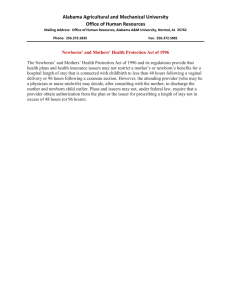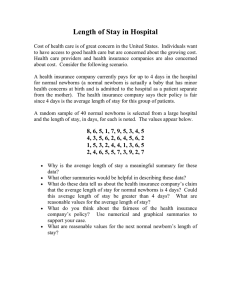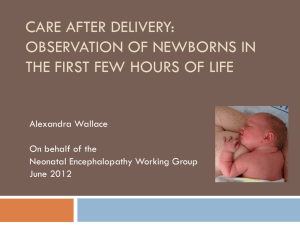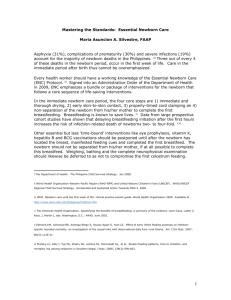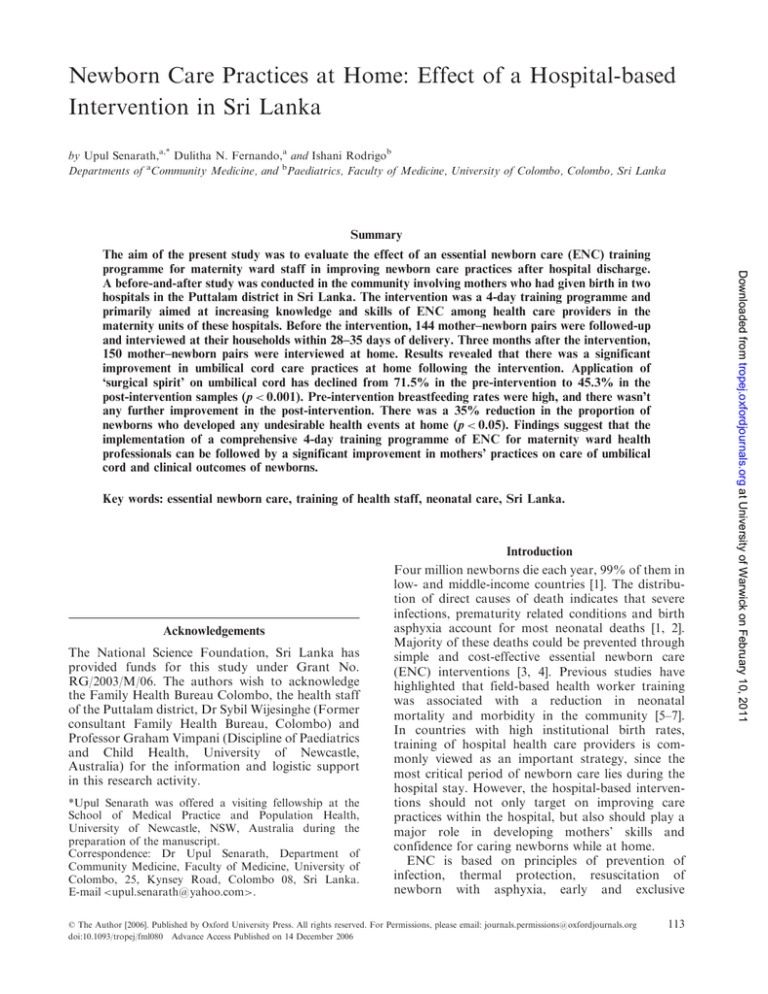
Newborn Care Practices at Home: Effect of a Hospital-based
Intervention in Sri Lanka
by Upul Senarath,a,* Dulitha N. Fernando,a and Ishani Rodrigob
Departments of aCommunity Medicine, and bPaediatrics, Faculty of Medicine, University of Colombo, Colombo, Sri Lanka
Summary
Key words: essential newborn care, training of health staff, neonatal care, Sri Lanka.
Acknowledgements
The National Science Foundation, Sri Lanka has
provided funds for this study under Grant No.
RG/2003/M/06. The authors wish to acknowledge
the Family Health Bureau Colombo, the health staff
of the Puttalam district, Dr Sybil Wijesinghe (Former
consultant Family Health Bureau, Colombo) and
Professor Graham Vimpani (Discipline of Paediatrics
and Child Health, University of Newcastle,
Australia) for the information and logistic support
in this research activity.
*Upul Senarath was offered a visiting fellowship at the
School of Medical Practice and Population Health,
University of Newcastle, NSW, Australia during the
preparation of the manuscript.
Correspondence: Dr Upul Senarath, Department of
Community Medicine, Faculty of Medicine, University of
Colombo, 25, Kynsey Road, Colombo 08, Sri Lanka.
E-mail <upul.senarath@yahoo.com>.
Introduction
Four million newborns die each year, 99% of them in
low- and middle-income countries [1]. The distribution of direct causes of death indicates that severe
infections, prematurity related conditions and birth
asphyxia account for most neonatal deaths [1, 2].
Majority of these deaths could be prevented through
simple and cost-effective essential newborn care
(ENC) interventions [3, 4]. Previous studies have
highlighted that field-based health worker training
was associated with a reduction in neonatal
mortality and morbidity in the community [5–7].
In countries with high institutional birth rates,
training of hospital health care providers is commonly viewed as an important strategy, since the
most critical period of newborn care lies during the
hospital stay. However, the hospital-based interventions should not only target on improving care
practices within the hospital, but also should play a
major role in developing mothers’ skills and
confidence for caring newborns while at home.
ENC is based on principles of prevention of
infection, thermal protection, resuscitation of
newborn with asphyxia, early and exclusive
ß The Author [2006]. Published by Oxford University Press. All rights reserved. For Permissions, please email: journals.permissions@oxfordjournals.org
doi:10.1093/tropej/fml080 Advance Access Published on 14 December 2006
113
Downloaded from tropej.oxfordjournals.org at University of Warwick on February 10, 2011
The aim of the present study was to evaluate the effect of an essential newborn care (ENC) training
programme for maternity ward staff in improving newborn care practices after hospital discharge.
A before-and-after study was conducted in the community involving mothers who had given birth in two
hospitals in the Puttalam district in Sri Lanka. The intervention was a 4-day training programme and
primarily aimed at increasing knowledge and skills of ENC among health care providers in the
maternity units of these hospitals. Before the intervention, 144 mother–newborn pairs were followed-up
and interviewed at their households within 28–35 days of delivery. Three months after the intervention,
150 mother–newborn pairs were interviewed at home. Results revealed that there was a significant
improvement in umbilical cord care practices at home following the intervention. Application of
‘surgical spirit’ on umbilical cord has declined from 71.5% in the pre-intervention to 45.3% in the
post-intervention samples (p < 0.001). Pre-intervention breastfeeding rates were high, and there wasn’t
any further improvement in the post-intervention. There was a 35% reduction in the proportion of
newborns who developed any undesirable health events at home (p < 0.05). Findings suggest that the
implementation of a comprehensive 4-day training programme of ENC for maternity ward health
professionals can be followed by a significant improvement in mothers’ practices on care of umbilical
cord and clinical outcomes of newborns.
U. SENARATH ET AL.
Materials and Methods
The study was conducted in the district of Puttalam
in the North Western province of Sri Lanka. In 2002,
the district reported 12 513 live births among a
mid-year-population of 721 230. The study followed
a before-and-after design involving mothers who had
given birth in hospitals before an intervention (preintervention) and 3 months after the intervention
(post-intervention). The Ethical Review Committee
of the Faculty of Medicine of University of Colombo
granted ethical clearance for this project.
Intervention
The intervention was a 4-day training programme
and primarily aimed at increasing knowledge and
skills of ENC among midwives, nurses and doctors in
the maternity units of two selected hospitals. These
health care providers were trained to educate
mothers on caring their newborns before, during
and after the delivery, and specifically through a
health education session before discharge from the
hospital. It was expected that the intervention would
improve newborn care practices of mothers and
the clinical outcomes of newborns following hospital
discharge. A 15-module training manual was compiled by the investigators in consultation with an
114
expert group and based on the findings of a baseline
survey. The contents were mainly extracted from the
WHO Training Modules on Essential Newborn Care
and Breastfeeding [4], Teaching Aids on Newborn
Care by the National Neonatology Forum India [13],
and Resuscitation of the Newborn by Resuscitation
Council, UK [14]. The 4-day training programme
consisted of 32 training hours and was conducted
with the involvement of 12 resource persons. The
number of hours spent on each module is listed in
Appendix 1. All the midwives, nurses and doctors
(n ¼ 59) in the obstetric units of the two hospitals
participated in the training programme.
Study sample
The study population consisted of mother–newborn
pairs who received care from these two hospitals,
irrespective of the mode of delivery. Those excluded
were cases where either the mother or newborn was
treated in an emergency setting (e.g. special-care
baby unit, premature baby unit, intensive care unit)
and there were multiple births, still births or neonatal
deaths in the present pregnancy. On the basis of the
results of some previous studies, it was estimated that
the baseline levels of most newborn care practices
were around 50%. To detect a 15% increase in the
stated outcomes (50–65%), with a power of 0.90
and error of 0.05, it was estimated that 223
mother–newborn pairs were required in each study
period [15].
Data collection
Basic socio-demographic data, details to locate the
households, knowledge about care of the newborn
and satisfaction with the care were obtained through
exit interview at the hospital upon discharge. During
the post-intervention phase, only those mothers who
participated in a post-natal health education session
were selected for the exit interview and the subsequent follow-up in the community. The trained
interviewers followed-up these mothers at their
households within 28–35 days after delivery. The
follow-ups were confined to a defined geographical
area (Chilaw and Marawila medical officer of health
areas). If a mother could not be traced at the first
instance, a subsequent attempt was made to meet her
within the specified duration, i.e. up to a maximum
of 42 days of delivery. The information obtained
through the household questionnaire focused on the
domiciliary care provided by public health midwife,
cleanliness in caring the newborn including care of
the umbilical stump, breastfeeding practices and
health problems in the newborn.
Data analysis
Data analyses were performed using SPSS version
10.0 (SPSS Inc., Chicago, IL, USA). The chi-square
test was applied to compare the frequency of
Journal of Tropical Pediatrics
Vol. 53, No. 2
Downloaded from tropej.oxfordjournals.org at University of Warwick on February 10, 2011
breastfeeding, care of the low birth weight babies and
identification and appropriate referral of sick neonates [3, 8]. It is estimated that 10–15% of under-five
deaths in resource-poor countries could be prevented
through achievement of universal coverage with
exclusive breastfeeding alone [9]. The World Health
Organization recommends keeping the umbilical cord
clean and dry without special treatment, except in
high-risk situations or in neonatal tetanus endemic
areas [10], and the evidence from a recent metaanalysis is in favour of these recommendations [11].
Thus, the practice of appropriate cord-care and
exclusive breastfeeding following hospital discharge
deserves greater emphasis in newborn care.
Recognition of effective strategies which have
an impact on both hospital and community practices
will be useful for health policy makers in planning
cost-effective interventions to improve newborn
outcomes. Among the developing countries,
Sri Lanka has reported a high institutional birth
rate (of the total births, 92% in government hospitals
and 4% in private health institutions) [12]. But, there
is no information regarding the effect of hospitalbased training strategies on newborn care practices
during hospital stay or following discharge from
hospital. The aim of the present study was to
evaluate whether the implementation of ENC training programme for hospital health care providers was
followed by improved newborn care practices of
mothers and the clinical outcomes of newborns, after
the discharge from hospital.
U. SENARATH ET AL.
individual practices before and after the intervention.
Of the 223 mother–newborn pairs interviewed upon
discharge in the pre-intervention phase, 79 (35.4%)
were not followed up at home because these mothers
lived outside the defined area. The corresponding
number in the post-intervention phase was 73
(32.7%) among 223 discharged mothers. Thus,
the analysis included 144 respondents in the preintervention and 150 in the post-intervention
samples. The non-reachable mother–newborn pairs
were not different from respondents with respect to
basic socio-demographic and health-care-related
characteristics.
Characteristics of the sample
As shown in Table 1, the differences in the baseline
characteristics of mother–newborn pairs were not
statistically significant between the two samples.
Teenage mothers represented 10.4 and 8.7% in the
pre- and post-intervention samples, whereas the firsttime mothers represented 41.7 and 43.3%, respectively. Forty-six mothers in the pre-intervention and
45% in the post-intervention samples had completed
10 years (General Certificate of Education Ordinary
Level) of education. The proportion of Caesarean
deliveries was 19.4% in the pre-intervention compared with 17.3% in the post-intervention.
The proportion of mothers who registered for
antenatal care before 14 weeks and those received
antenatal education of newborn care were not
significantly different between pre-intervention and
post-intervention samples.
Perceptions about the health advices
During the exit interview, mothers were asked
whether they were satisfied with the health advices
given by the hospital health staff to look after the
newborn baby. Mothers were also asked if they were
satisfied about the opportunity given to them to
clarify doubts about the care of the newborn. The
responses were marked in a 5-point Likert scale.
In the pre-intervention group, 56.7% were satisfied
with the health advises on caring the newborn
compared with 92.5% in the post-intervention.
With respect to opportunity to clarify doubts,
47.9% in the pre-intervention and 84.7% in the
post-intervention
samples
expressed
their
satisfaction.
Care of the umbilical cord
Table 2 indicates that application of ‘surgical spirit’
on umbilical cord has declined significantly from
71.5% in the pre-intervention to 45.3% in the postintervention samples (p < 0.001). There were significant reductions in the unwanted cord-care practices
such as putting dressing to umbilical stump
Journal of Tropical Pediatrics
Vol. 53, No. 2
Characteristic
Pre-intervention
sample (n ¼ 144)
Maternal age (years)
19
20–34
35
Parity
Primiparae
Multiparae
Ethnicity
Sinhalese
Tamil
Moor
Maternal educational
level
Below GCE
(O/level)
GCE (O/level)
and above
Maternal employment
Employed
Not employed
Registration for
antenatal care
<14 weeks
14 weeks
Antenatal education
of newborn care
Received
Not received
Mode of delivery
Vaginal
Caesarean
Birth weight
of newborn
<2500 g
2500 g
GCE (O/level),
Ordinary Level.
Post-intervention
sample (n ¼ 150)
No.
(%)
No.
(%)
15
117
12
10.4
81.3
8.3
13
123
14
8.7
82.0
9.3
60
86
41.7
59.7
65
85
43.3
56.7
119
10
15
82.6
6.9
10.4
121
11
18
80.7
7.3
12.0
78
54.2
83
55.3
66
45.8
67
44.7
19
125
13.2
86.8
25
125
16.7
83.3
111
33
77.1
22.9
114
36
76.0
24.0
105
39
72.9
27.1
104
46
69.3
30.7
116
28
80.6
19.4
124
26
82.7
17.3
20
124
13.9
86.1
23
127
15.3
84.7
General
Certificate
of
Education
(from 13.9% to 5.3%; p < 0.05) and covering the
stump with baby’s nappy (31.9–14.0%; p < 0.01).
In the pre-intervention phase, only 35.4% of newborns were bathed before cord stump had fallen off,
and this proportion increased to 53.3% (p < 0.01)
following intervention. According to the exit interviews, there was a significant increase in the knowledge among mothers on the care of umbilical cord.
Such improvement was accompanied by improved
practices on care of umbilical cord following the
intervention.
Breastfeeding practices
As shown in Table 2, the indicators of breastfeeding
were very satisfactory in the pre-intervention sample,
with 91.7% newborns were exclusively breastfed,
115
Downloaded from tropej.oxfordjournals.org at University of Warwick on February 10, 2011
Results
TABLE 1
Baseline characteristics of mother–newborn pairs
U. SENARATH ET AL.
TABLE 2
Care of the umbilical cord and breastfeeding practices before and 3 months after intervention
Practice
Post-intervention
(n ¼ 150) %
Significance
13.9
60.4
75.0
71.5
35.4
31.9
5.3
69.3
78.7
45.3
53.3
14.0
2 ¼ 6.24 p ¼ 0.012
2 ¼ 2.57 NS
2 ¼ 0.56 NS
2 ¼ 20.7 p ¼ 0.000
2 ¼ 9.55 p ¼ 0.002
2 ¼ 13.44 p ¼ 0.002
91.7
98.6
100
4.9
93.6
98.0
100
4.0
NS
NS
NS
NS
NS, not significant (p 0.5).
100% ever-breastfed and 4.9% bottle-fed by 4 weeks
of age. These rates remained relatively constant at the
post-intervention sample, without any significant
improvement or decline.
Clinical outcomes of newborns
The numbers and rates of different undesirable
health events of the newborns, as reported by
mothers in the pre- and post-intervention samples
are listed in Table 3. Nine (6.3%) newborns in the
pre-intervention had skin pustules compared with
five (3.3%) in the post-intervention sample (p > 0.05).
Eight (5.6%) newborns had signs suggestive of
umbilical sepsis in the pre-intervention compared
with five (3.3%) in the post-intervention (p > 0.05).
As summarized in Table 4, during the postintervention phase, 33 out of 150 newborns (22.0%)
had experienced any undesirable health events since
being taken home until the completion of the
neonatal period. In comparison with the corresponding baseline rate, this was a 35% reduction
(2 ¼ 5.28; p < 0.05), indicating the effect of the
intervention at community level. Even though the
incidence of superficial infections has declined from
15.3/100 newborns to 8.7/100 newborns, the difference was not statistically significant, probably due to
the small sample size.
Discussion
Our results indicate that educating heath care workers about the current recommendations of umbilical
cord care was an effective strategy in changing
maternal behaviour. Given the evidence of no
additional benefits of topical antiseptics [11, 16],
and the country’s achievement of neonatal tetanus
elimination status [17], maternal and child health
services in Sri Lanka recommends that umbilical cord
should be kept open without any application or
116
TABLE 3
Undesirable health events among newborns since
being taken home until completion of 28 days,
before and 3 months after intervention
Undesirable
health event
Infections
Umbilical sepsis
Skin infection
Conjunctivitis
Rapid breathing
or chest
in-drawing
Diarrhoea
Upper respiratory
infections
Oral thrush
Hypothermia
Unexplained fever
Other morbidities
Constipation
Convulsions
Neonatal jaundice
Other signs and
symptoms not
classified
elsewhere
Pre-intervention
(n ¼ 144)
Post-intervention
(n ¼ 150)
No.
(%)
No.
(%)
8
9
3
6
5.6
6.3
2.1
4.2
5
5
2
1
3.3
3.3
1.3
0.7
1
12
0.7
8.3
1
10
0.7
6.7
2
1
3
1.4
0.7
2.1
1
0
5
0.7
0.0
3.3
3
1
6
3
2.1
0.7
4.2
2.1
2
0
5
2
1.3
0.0
3.3
2.1
Nine newborns in the pre-intervention and seven
newborns in the post-intervention phase had more than
one undesirable health events.
dressing. However, the use of topical applications on
cord stump was a common practice at home, with
71.5% of mothers in the pre-intervention sample
applying ‘surgical spirit’ on it. This was possibly due
to the inappropriate health messages that mothers
Journal of Tropical Pediatrics
Vol. 53, No. 2
Downloaded from tropej.oxfordjournals.org at University of Warwick on February 10, 2011
Care of the umbilical cord
Umbilical stump was covered with a dressing
The stump was washed with water while bathing
The stump was dried thoroughly after bathing
Surgical spirit was applied on the stump
Baby was bathed before the cord stump had fallen
Umbilical stump was covered with the baby’s nappy
Breastfeeding practices
Exclusive breastfeeding rate by 28 days
Predominant breastfeeding rate
Ever-breastfed rate since arrival at home
Bottle feeding rate
Pre-intervention
(n ¼ 144) %
U. SENARATH ET AL.
TABLE 4
Clinical outcomes of newborns since being taken home until completion of 28 days, before
and 3 months after intervention
Indicator
Pre-intervention Post-intervention Percent change
% (n ¼ 144)
% (n ¼ 150)
from pre
to post
Newborns with any undesirable health event
Total undesirable health events per 100 newborns
Incidence of superficial infectionsa per 100 newborns
Re-admissions to hospital per 100 newborns
34.0
40.3
15.3
1.39
22.0
26.7
8.7
1.33
35.3
33.7
43.1
4.3
Significance
2 ¼ 5.28
2 ¼ 6.13
2 ¼ 3.06
2 ¼ 0.21
p ¼ 0.02
p ¼ 0.013
NS
NS
a
received from health staff or other sources about
cord-care. Thus, the perinatal health care providers
should be trained to disseminate consistent messages
about the current recommendation of cord-care in
the country.
The present study revealed that 91.7 and 93.6% in
the pre- and post-intervention samples of newborns,
respectively, were exclusively breastfed at 28 days
of life. Successful breastfeeding practices in the
community were attributed to the consistent efforts
made by the health services in training health
care providers and educating mothers during pregnancy, delivery and postpartum periods on breastfeeding [18–20]. Social and cultural aspects, which
were in favour of breastfeeding, would also have
contributed in promoting these practices. A nationally representative survey (The Demographic and
Health Survey 2000) revealed that exclusive breastfeeding rate was 50.8% at 4 months [12]. The factors
associated with poor exclusive breastfeeding rate in
the country include lack of antenatal education on
breastfeeding, Caesarean or complicated vaginal
deliveries, mother’s employment away home and
mothers’ perception of inadequate milk [19]. Several
previous studies have shown that a breastfeeding
training programme for maternity ward staff was
followed by increased breastfeeding rates in community [21, 22]. In order to sustain high breastfeeding
rates, we recommend that the training programmes
for health staff on breastfeeding should be continued,
focussing on women at risk of discontinuation of
exclusive breastfeeding.
A field trial in India provided evidence for decline
in a broad range of morbidities following an
introduction of a comprehensive home-based
neonatal care package [6]. The effect of our
intervention did not reflect on individual morbidities,
but occurred on overall incidence of morbidities.
A higher sample size would require to make
comparisons between individual morbidities with
adequate statistical power. However, the focus of
our intervention was on newborn care practices
and overall neonatal outcome. The reduction in
Journal of Tropical Pediatrics
Vol. 53, No. 2
incidence of infections (Tables 3 and 4) could be
mainly attributed to the improved practices of
cleanliness including appropriate care of the umbilical cord.
One limitation of our study design was the absence
of a control group, thus we cannot exclude the
natural changes in practices over the time that could
occur in the absence of the intervention. We could
not achieve the expected sample size since the
household interviews were confined to a defined
geographic area.
In conclusion, our findings suggest that the
implementation of a comprehensive 4-day training
programme of ENC for the maternity ward health
professionals can be followed by a significant
improvement in mothers’ practices on care of
umbilical cord. This intervention possibly has an
effect on reducing undesirable health events generally
among healthy newborns following the discharge.
However, the study does not provide sufficient
evidence regarding the influence on incidence of
individual health problems.
References
1. Lawn J, Cousens S, Zupan J. 4 million neonatal deaths:
When? Where? Why? Lancet 2005;365:891–900.
2. Investigators of the National Neonatal Perinatal
Database (NNPD) National Neonatology Forum of
India. Morbidity and mortality among outborn neonates at 10 tertiary care institutions in India during the
year 2000. J Trop Pediatr 2004;50:170–7.
3. World Health Organization. Essential Newborn Care –
Report of a Technical Working Group. Geneva: World
Health
Organization
(WHO/FRH/MSM/96.13).
Geneva: World Health Organization, 1996.
4. World Health Organization. Training Modules on
Essential Newborn Care and Breast Feeding.
Copenhagen: World Health Organization, 2002.
5. Bang AT, Bang RA, Baitule SB, et al. Effect of homebased neonatal care and management of sepsis on
neonatal mortality: field trial in rural India. Lancet
1999;354:1955–61.
6. Bang AT, Bang RA, Reddy HM, et al. Reduced
incidence of neonatal morbidities: effect of home-based
117
Downloaded from tropej.oxfordjournals.org at University of Warwick on February 10, 2011
skin pustules, red eyes with purulent discharge, whitish plaques in the oral mucosa and signs suggestive of umbilical sepsis
were considered as superficial infections.
NS, not significant (p 0.5).
U. SENARATH ET AL.
7.
8.
9.
10.
11.
13.
14.
15. Pocock S. Clinical Trials – A practical Approach.
Chichester: John Wiley & Sons, 1983.
16. Bourke E. Cord care: too much or too little. Aust J Adv
Nurs 1990;7:19–22.
17. Kulathilaka T, Jayakuru W. Development of
epidemiological services in Sri Lanka and future
challenges. J Commun Phys Sri Lanka 2001;
Millennium suppl:21–8.
18. Senanayake M, Wijemanne M. How baby friendly
hospitals can improve child health. Ceylon J Child
Health 1992;21:33–4.
19. Jayathilaka CA, Fernando DN. A community-based
study on breastfeeding practices in Gampaha district.
J Commun Phys Sri Lanka 2002;7:32–6.
20. Family Health Bureau. Annual Report on family
health Sri Lanka. Colombo: Family Health Bureau,
2001.
21. Vittoz JP, Labarere J, Castell M, et al. Effect
of a training program for maternity ward professionals on duration of breastfeeding. Birth 2004;31:
302–7.
22. Cattaneo A, Buzzetti R. Quality improvement
report: effect on rates of breast feeding of training for
the baby friendly hospital initiative. Br Med J 2001;323:
1358–62.
APPENDIX 1
Duration of training modules in the 4-day training programme on ENC for health care providers
Training module
Duration
Introduction to workshop
1. Neonatal health and principles of essential newborn care
2. Care of the healthy newborn
3. Cleanliness/prevention of infections in the maternity unit
4. Initiation of breathing and resuscitation at birth
5. Partogram with special emphasis on the health of the newborn
6. Breastfeeding management in the healthy newborn
7. Breastfeeding difficulties
8. Baby friendly hospital initiative
9. Neonatal infections
10. Neonatal jaundice
11. Care of the premature/low birth weight baby
12. Newborns with birth trauma or birth defects
13. BCG immunization
14. How to give an effective health talk
15. Care of the newborn in the community
Preparation of action plans, presentations and winding-up
Total duration
1h
1h
2h
4h
3 h 30 min
1h
2h
1 h 45 min
1h
2h
1h
2h
1 h 45 min
2h
2h
1 h 30 min
2 h 30 min
32 h
118
Journal of Tropical Pediatrics
Vol. 53, No. 2
Downloaded from tropej.oxfordjournals.org at University of Warwick on February 10, 2011
12.
neonatal care in rural Gadchiroli, India. J Perinatol
2005;25:S51–61.
Bhutta Z, Darmstadt G, Hasan B, et al. Communitybased interventions for improving perinatal and
neonatal health outcomes in developing countries: a
review of the evidence. Pediatrics 2005;115:519–617.
Costello A, Manandhar D, (Eds.). Improving newborn
health in developing countries. London: Imperial
College Press, 1998.
Jones G, Steketee RW, Black RE, et al. How many
child deaths can we prevent this year? Lancet 2003;362:
65–71.
World Health Organization. Care of the umbilical cord:
a review of the evidence. WHO/RHT/MSM/98.4.
Geneva: World Health Organization, 1998.
Zupan J, Garner P, Omari A. Topical umbilical cord
care at birth. The Cochrane Database of Systematic
Reviews, 2004.
Department of Census and Statistics Sri Lanka.
Sri Lanka Demographic and Health Survey.
Colombo: Department of Census and Statistics, 2000.
National Neonatology Forum. NF teaching aids on
newborn care. Resource Book. New Delhi, 1998.
Resuscitation Council UK. The Newborn Life Support
Provider Course Manual. London, 2001.

